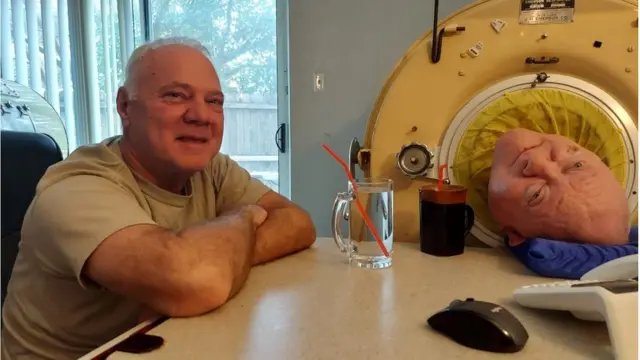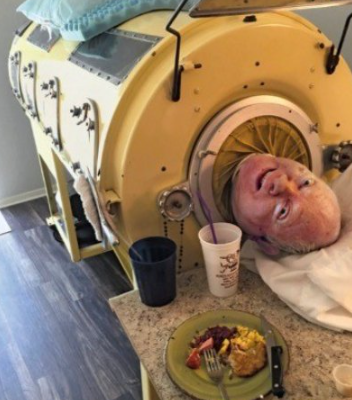
Paul Alexander


In remembering the life of Paul Alexander, we trace a journey that stretches far beyond the cold metal of an iron lung. It’s a story of resilience, innovation, and the human spirit refusing to be defined by its limitations.
The Crisis: A Childhood Storm
In 1952, at the age of six, Paul Alexander contracted Poliomyelitis (polio) during a major outbreak in the United States. ABC+2rotary.org+2 The virus paralyzed him from the neck down, and his diaphragm no longer could pump air in and out of his lungs. In response, doctors placed him inside a negative-pressure ventilator known as an iron lung — a large metal cylinder that sealed around his body, the head exposed, and mechanically alternated air pressure to inflate and deflate his lungs. The Washington Post+1
He was told he might not survive. The sounds of the machine — the hiss and sigh of the bellows — became his lifeline. “He woke up inside the machine… he couldn’t speak, couldn’t move.” The Washington Post
Surrounded by rows of children in similar respirators, Paul experienced the stark reality of polio in its grim days — a reality largely foreign to new generations. ABC+1
The Breakthrough: Teaching Himself to Breathe
What followed might feel impossible: Paul taught himself to breathe outside the machine for short periods. He developed a technique—he called it “frog breathing”—involving gulping air and swallowing it. The Washington Post+1 His reward? A dog, promised by a nurse if he could breathe on his own for three minutes. He achieved it and named the pup Ginger. euronews
This milestone didn’t mark the end of the iron lung — in fact, he continued to use it for decades — but it marked the start of a life that refused to be surrendered. He later learned to leave the machine for hours, attend classes, and engage with the world outside that metal cylinder. rotary.org+1
The Achievements: A Life Beyond the Machine
Paul didn’t accept confinement as destiny. He went to high school (graduating around age 21 with a tutor at home) and earned a bachelor’s degree at the University of Texas in 1978. The Washington Post+1 He then attended law school and passed the bar — becoming an attorney practicing civil and criminal law in Dallas. rotary.org+1
To accommodate his condition, Paul operated from an electric-powered wheelchair, with his body either in or near his iron lung. He typed with a plastic stick in his mouth, used assistive technology, and mobilized helpers for court appearances. rotary.org+1 He also wrote a memoir titled Three Minutes for a Dog: My Life in an Iron Lung (2020). euronews+1
He became a public voice — on social media, speaking about his life, disability rights, polio vaccination, resilience. By early 2024 he had launched a TikTok account under @ironlungman. ABC+1
The Significance: More Than One Man’s Story
Paul’s story operates on multiple levels:
-
Medical History: He was among the very last people still relying on an iron lung — devices once common during the polio era but largely retired after mechanical ventilators and vaccines. The Washington Post His life is a living remembrance of a disease largely forgotten by younger generations.
-
Disability and Autonomy: He refused to be defined solely by paralysis. He embraced the machine as a tool rather than a prison, and sought degrees, legal work, relationships, and self-expression. He once said when asked if his lifelong disability felt unfair: “I never looked at it that way. I took it like, ‘Wow, God picked me out to do this.’” https://www.whsv.com
-
Vaccination & Public Health: His very existence is a testament to the severity of polio, and a stark reminder that diseases thought gone can resurge if vigilance disappears. In his interviews, Paul showed concern that new generations do not know polio’s danger. ABC
-
Legacy of Resilience: His attitude — “I enjoyed the struggle. I enjoyed the challenges.” https://www.wbrc.com — inspired countless people. Friends described him as “one of the bright stars of this world” and a man who taught others to free themselves from self-imposed limits. Dallas Express
The Final Chapter: Departure & Remembrance
On March 11, 2024, Paul Alexander passed away at age 78 in Dallas, Texas. euronews He had recently been hospitalized after contracting COVID-19, though the exact cause of death was unspecified. People.com
His brother, Philip Alexander, wrote: “So many people were inspired by Paul… I am just so grateful.” The Washington Post Friends and admirers around the world mourned the loss, honoring him as an extraordinary figure who lived on his own terms.
At his funeral, those who knew him spoke not about pity or limitation, but about his optimism, his refusal to be hindered, his ambition despite the iron lung. Gary Cox, a friend, said: “Paul could do anything in his spirit, and I’m over here putting all my own limitations on myself.” Dallas Express
Why “The Breath Between the Bars”?
The title of this remembrance draws on metaphor and reality:
-
Bars: The iron lung’s cylindrical shape, the enclosure of body and machine; the visible “barrier” between Paul and unassisted respiration; the barrier society sometimes places between expectations and individuals with disabilities.
-
Breath: Life’s fundamental rhythm. Paul’s breath was mechanical assisted for decades, yet he worked to reclaim some autonomy. His “breath between the bars” becomes a symbol for life thriving despite walls — physical, societal, mental.
-
Between: A liminal space — neither fully free of the machine nor defined by it alone. Paul lived in the space between confinement and self-realization, between dependence and achievement, between history and modernity.
Key Takeaways
-
The human spirit can transcend incredible odds. An iron lung is not an end — in Paul’s case, it became a beginning.
-
Disability is not inability. Paul’s life challenges misconceptions about what’s possible when one is paralyzed from the neck down.
-
History matters. Polio’s devastation once prompted fear across the world. Paul reminded us of that history and the importance of vaccines.
-
Purpose can emerge from limitation. Paul turned his machine into a platform, his condition into a voice, his confinement into inspiration.
-
Legacies live. Though the iron lung turned quiet, Paul’s message — of hope, of action, of resisting surrender — endures.
Final Reflections
When we think of Paul Alexander, we must resist the impulse to look only at the machine, the paralysis, the struggle. Instead, we look at the human who filled that machine with laughter, ambition, advocacy. We see someone who asked not “Why me?” but “Why not me?” We see a lawyer, author, TikTok creator, friend, advocate.
His life raises questions for all of us: What machines or walls confine us? What breaths do we take for granted? What spaces could become possibilities if we refuse to let them define us?
Paul once said, “I don’t know anyone in the world who breathes like I do — it keeps me alive.” The Washington Post Perhaps the truth is deeper: the machine kept him alive, but his spirit gave him life.
In remembering him, we honor not the metal and mechanics, but the man. Not the confinement, but the expansion. Not a life defined by disease, but a life defined by courage.
Rest in peace, Paul Alexander — your breath between the bars will resonate in many hearts for many years to come.

